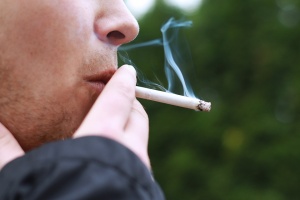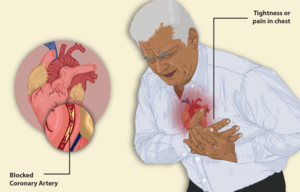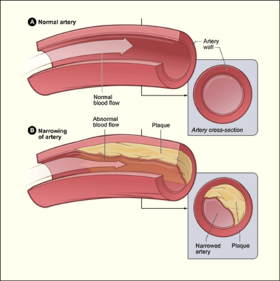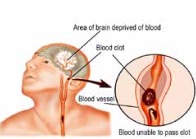Smoking and Exercise: Difference between revisions
No edit summary |
No edit summary |
||
| (41 intermediate revisions by 12 users not shown) | |||
| Line 1: | Line 1: | ||
= ''' | <div class="editorbox"> | ||
'''Original Editors '''- [[User:Lance Ramos|Lance Ramos]] | |||
'''Top Contributors''' - {{Special:Contributors/{{FULLPAGENAME}}}} | |||
</div> | |||
== Introduction == | |||
[[File:Smoking-1026556 960 720-2.jpg|right|frameless]] | |||
Smoking causes both immediate and long-standing effects on [[Therapeutic Exercise|exercise]] and [[Physical Activity|physical activity]] (PA). Smokers’ increased risks for [[Oncology|cancer]] and heart and respiratory diseases are well known. In terms of exercise and physical activity, smokers also have: | |||
* Less endurance | |||
* Poorer physical performance | |||
* Increased rates of injury and complications<ref name=":0">Cleveland Clinic [https://my.clevelandclinic.org/health/articles/10643-smoking-and-physical-activity Smoking and PA] Available from:https://my.clevelandclinic.org/health/articles/10643-smoking-and-physical-activity (accessed 8.4.2021)</ref>. | |||
To achieve peak performance, the heart, lungs and muscles need oxygen-rich blood. When you inhale tobacco smoke, carbon monoxide (just one of the 4,000-plus chemicals found in tobacco, more than 50 of which are known to cause cancer) binds to red blood cells. Oxygen is displaced, preventing delivery to the muscles and other body tissues. This causes an increase in lactic acid i.e. the substance that causes muscle “burning,” fatigue, heavier breathing, and increased soreness after exercise. | |||
This decrease in oxygen will reduce physical endurance e.g. It makes it harder to do everyday things, too, like walking up stairs. Decrease in oxygenation also causes a smoker’s resting heart rate to be higher than a nonsmoker’s, as the heart must work harder to deliver enough oxygen to the body.<ref name=":0" /> | |||
== Cardiorespiratory Effects == | |||
[[File:Heart Attack.png|right|frameless]] | |||
Due to the effects of smoking on the cardiovascular system, the heart is not capable of pumping sufficient blood to supply adequate oxygen. Due to insufficient supply of oxygen, the ability of smokers to exercise and perform daily physical activities are also hampered and this ultimately increases the risk of strokes and heart attacks. | |||
Inhaling the smoke of tobacco can cause different responses instantly in the heart and blood vessels. The effects of smoking on the cardiovascular system begin immediately after its consumption. | |||
* Within one minute of smoking, heart rate starts increasing and it may increase up to 30% in the first ten minutes of smoking. | |||
* Nicotine present in the tobacco releases adrenaline that makes the heart beat faster and increases the flow of blood, thereby pressuring the heart to work faster and harder. | |||
* The carbon monoxide present in the tobacco smoke puts your heart at risk of harmful effects by decreasing the ability of blood to carry oxygen to the organs. | |||
Specific Changes and or Increased risk of:[[File:Atherosclerosis diagram.png|right|frameless|281x281px]] | |||
= | # [[Atherosclerosis]] | ||
# Low [[Blood]] Oxygen | |||
# [[Coronary Artery Disease (CAD)|Coronary Heart Disease]]: Smoking is a huge risk factor for coronary artery disease and many other complications e.g. myocardial infarction and sudden death<ref name="Fernhall">Fernhall B, Mendonca G, Pereira F. [https://www.tandfonline.com/doi/abs/10.1080/02640414.2011.572991 Effects of cigarette smoking on cardiac autonomic function during dynamic exercise]. J Sport Sci 2011;29:879-86</ref>. It is also associated with increased blood pressure, systemic vascular resistance, and heart rate<ref name="Fernhall" />. Nicotine is one factor that stimulates epinephrine and norepinephrine release from the sympathetic nerve terminals and adrenal glands,<ref name="Fernhall" />. Acute cigarette smoking is associated with a significant decrease in vagal cardiac modulations which may increase the risk of complications during daily exercise or intense physical activity<ref name="Fernhall" />. Acute smoking affects the cardiorespiratory responses to both submaximal and maximal exercise, which can result in an increase of sympathetic dominance at lower levels of submaximal work<ref name="Fernhall" />. | |||
# [[Deep Vein Thrombosis|Blood Clots]]: The smokers are more vulnerable to strokes and heart attacks because due to smoking there is less room for blood to flow to the brains and heart through the blood vessels, due to hypertension Also the level of fibrinogen increases in smokers. This increases the risk of formation of blood clots in the blood vessels<ref>painassist Effects of smoking Available from:https://www.epainassist.com/chest-pain/heart/7-effects-of-smoking-on-the-cardiovascular-system (accessed 8.4.2021)</ref>. [[File:Stroke 2.jpg|right|frameless|196x196px]] | |||
# [[Stroke]] | |||
# Thromboangiitis Obliterans or Buerger’s Disease: rare type of peripheral arterial disease that usually affects the medium and small arteries, veins of legs and arms. Buerger’s Disease is another effect of smoking on the cardiovascular system and in some studies it is discovered that passive smokers are also at risk of developing such diseases. This disease mainly occurs in young smokers that age between 20 and 45. | |||
# [[Peripheral Arterial Disease]]: one of the common effects of smoking on the cardiovascular system. | |||
# Hyperlipidaemia. | |||
Smoking | == Effects of Smoking on the Respiratory System == | ||
[[File:Coughing.jpeg|right|frameless]] | |||
Some of the most commonly known effects of smoking are those related to the respiratory system. | |||
The | The chemicals in tobacco smoke can damage the respiratory system in many ways. | ||
This | Examples: | ||
* Tar is a sticky substance that coats your lungs like soot in a chimney. | |||
* Phenols paralyse and kill the hair-like cells in your airways. These cells sweep clean the lining of your airways and protect them against infections. | |||
* Tiny particles in tobacco smoke irritate your throat and lungs and cause ‘smoker’s cough’. This increases production of mucus and damages lung tissue. | |||
* Ammonia and formaldehyde irritate your eyes, nose and throat. | |||
* Cancer-causing chemicals make your cells grow too fast or abnormally and can result in cancer cells.<ref>Aust Gov. Smoking effects Available from:https://www.health.gov.au/health-topics/smoking-and-tobacco/about-smoking-and-tobacco/what-are-the-effects-of-smoking-and-tobacco (accessed 8.4.2021)</ref> | |||
* Research looking at direct exposure to smoking has shown that moderate and heavy smokers have a decreased VO2max. There tends to be a stronger correlation in men, and the decrease in VO2max caused by smoking becomes more significant with age<ref name="Bernaards et al">Bernaards CM, Twisk JW, Van Mechelen W, Snel J, Kemper HC. [https://scholar.google.com/scholar_url?url=https://psycnet.apa.org/record/2003-00653-002&hl=en&sa=T&oi=gsb&ct=res&cd=0&d=16282103726194542725&ei=NuSuY5qeA86vywS1g6foAw&scisig=AAGBfm27Zm2jzvYwEjC6OlPfYngkgMLXnA A longitudinal study on smoking in relationship to fitness and heart rate response.] Medicine & Science in Sports & Exercise. 2003 May. </ref>. Furthermore, smoking just prior to exercise results in less oxygen availability at the tissue level<ref name="Hansen et al">Hirsch GL, Sue DY, Wasserman KA, Robinson TE, Hansen JE. [https://scholar.google.com/scholar_url?url=https://journals.physiology.org/doi/abs/10.1152/jappl.1985.58.6.1975&hl=en&sa=T&oi=gsb&ct=res&cd=0&d=2401442079248795554&ei=U-SuY5yFEZCXywSwqaaIDw&scisig=AAGBfm26lwR8zeFIR2PyhDhB5lYLkJEsQQ Immediate effects of cigarette smoking on cardiorespiratory responses to exercise]. Journal of Applied Physiology. 1985 Jun 1;58(6):1975-81.</ref>. | |||
== Musculoskeletal Effects == | |||
= | === Bone Density === | ||
Smoking has also been found to have a negative effect on bone mineral density which is directly related to [https://www.physio-pedia.com/Osteoporosis osteoporotic] fracture<ref name="krall">Krall EA, Dawson-Hughes B. [https://scholar.google.com/scholar_url?url=https://asbmr.onlinelibrary.wiley.com/doi/abs/10.1359/jbmr.1999.14.2.215&hl=en&sa=T&oi=gsb&ct=res&cd=0&d=5535149142029664252&ei=eeSuY5mlFMSYywTZh5fgCg&scisig=AAGBfm2jHppZnA0rktspFPjfKUlRYuwEcA Smoking increases bone loss and decreases intestinal calcium absorption]. J Bone Miner Res 1999;14:215–20. doi: 10.1359/jbmr.1999.14.2.215</ref>. Smokers do not absorb supplemental or dietary calcium as well as non-smokers. Studies show that smokers on average have 20mg/day less calcium available than non-smokers. The full reason in which calcium absorption is decreased is still unclear, but one explanation is that smoking damages intestinal villi which is a major component in digestion and absorption of nutrients<ref name="krall" />. The decreased ability to absorb calcium leading to decreased bone mineral density increases the risk of osteoporotic fracture with exercise. | |||
=== Sarcopenia === | |||
* The use of cigarettes and other tobacco products has also been found to be a contributing factor to age-related muscle atrophy, which is known as [https://www.physio-pedia.com/Sarcopenia sarcopenia]. When compared to non-smokers of similar backgrounds those who did smoke had evidence of increased muscle tissue deterioration<ref>Rom O, Kaisari S, Aizenbud D, Reznick A. [https://scholar.google.com/scholar_url?url=https://link.springer.com/article/10.1007/s10974-013-9355-8&hl=en&sa=T&oi=gsb-ggp&ct=res&cd=0&d=18285817331106422852&ei=p-SuY-b7Bc6vywS1g6foAw&scisig=AAGBfm10QAxcMWhjEA_llZwk3OhUUF_hDA Identification of possible cigarette smoke constituents responsible for muscle catabolism.] J Muscle R and Cell Motility 2012;33(3):199-208. doi:10.1007/s10974-012-9299-4</ref>. Type I fibers are specifically affected which would limit muscular endurance<ref name="typeI">Ide H, Tabira K. [https://scholar.google.com/scholar_url?url=http://rc.rcjournal.com/content/58/11/1892.short&hl=en&sa=T&oi=gsb&ct=res&cd=0&d=7366803437012240499&ei=weSuY7q3AtKxywSLm5agCA&scisig=AAGBfm3lloWEkoBaTup_En9VmM74SW6kDQ Changes in sympathetic nervous system activity in male smokers after moderate-intensity exercise]. Respiratory Care 2013; 58:1892-98</ref>. The use of tobacco products can also cause excessive amounts of adipose tissue catabolism during and after exercise. This can also lead to muscle tissue wasting in those who are nutritionally deficient. Researchers believe that this is a cause for a condition known as cachexia, condition usually seen in patients with cancer or congestive heart failure<ref name="typeI" /> in which the patient loses muscle mass to aging. | |||
* This loss of muscle mass can lead to less productivity during exercise in regards to energy output and respiration efficiency. Upper extremity muscles also serve as muscles of respiration, which should be taken into consideration while working to condition patients who are heavy smokers. A controlled trial used upper body resistance exercises to study their effects on breathing among a sample of sedentary male smokers. There was, in fact, a significant effect on forced expiration and forced vital capacity within the exercise group <ref>Singh VP, Jani H, John V, Singh P, Joseley T. [https://scholar.google.com/scholar_url?url=https://www.ncbi.nlm.nih.gov/pmc/articles/PMC4009654/&hl=en&sa=T&oi=gsb-ggp&ct=res&cd=0&d=18433077998069176310&ei=2eSuY7fVL8SYywTZh5fgCg&scisig=AAGBfm3S1Y9p_6Lknn9ndxyBVrv7qzJQPA Effects of upper body resistance training on pulmonary functions in sedentary male smokers]. Lung India : Official Organ of Indian Chest Society 2011:28(3);169–73. doi: 10.4103/0970-2113.83971</ref>. | |||
== Smokers Exercise Less == | |||
Smoking can also decrease the amount a person exercises. | |||
* In a study done by Loprinzi and Walker, the variables of nicotine dependence and the amount of exercise per day were compared. They further divided the participants to account for other variables including age, gender, race, and several others. Through data analyses, this study found that there was a positive correlation between higher levels of nicotine dependence and sedentary behavior in participants 50 years of age or older. The study also found that older participants were more dependent on nicotine. <ref>Loprinzi PD, Walker JF. [https://scholar.google.com/scholar_url?url=https://www.ncbi.nlm.nih.gov/pmc/articles/PMC3731864/&hl=en&sa=T&oi=gsb-ggp&ct=res&cd=0&d=18432143262973270087&ei=_eSuY7KRDZCXywSwqaaIDw&scisig=AAGBfm2H1Ipee3913y47FN6kGBHO_qNcSA Nicotine dependence, physical activity, and sedentary behavior among adult smokers.] North American Journal of Medical Sciences 2015:7(3);94-9. doi: 10.4103/1947-2714.153920</ref> Individuals who smoke may exercise less and may require more motivation to participate in a more active lifestyle. | |||
= References = | == References == | ||
<references /><br> | <references /><br> | ||
[[Category:Physical Activity]] | |||
[[Category:Chronic Respiratory Disease - Conditions]] | |||
Latest revision as of 15:05, 30 December 2022
Original Editors - Lance Ramos
Top Contributors - Trevor McKay, Brandi Kindiger, Christopher Ahrens, Allee Tatum, Vidya Acharya, James Williams, Emily North, Ryan Staebell, Lucinda hampton, Alyxandria Davis, Burgundy Cribbs, Robert Long, Lance Ramos, Kim Jackson, Maddisen Coleman, Alan Tran, Chelsea Mclene, Kyle Covey, Devyn Redford, Kelly Fossard, Michelle Lee, Taylor Ledford and Josh Williams
Introduction[edit | edit source]
Smoking causes both immediate and long-standing effects on exercise and physical activity (PA). Smokers’ increased risks for cancer and heart and respiratory diseases are well known. In terms of exercise and physical activity, smokers also have:
- Less endurance
- Poorer physical performance
- Increased rates of injury and complications[1].
To achieve peak performance, the heart, lungs and muscles need oxygen-rich blood. When you inhale tobacco smoke, carbon monoxide (just one of the 4,000-plus chemicals found in tobacco, more than 50 of which are known to cause cancer) binds to red blood cells. Oxygen is displaced, preventing delivery to the muscles and other body tissues. This causes an increase in lactic acid i.e. the substance that causes muscle “burning,” fatigue, heavier breathing, and increased soreness after exercise.
This decrease in oxygen will reduce physical endurance e.g. It makes it harder to do everyday things, too, like walking up stairs. Decrease in oxygenation also causes a smoker’s resting heart rate to be higher than a nonsmoker’s, as the heart must work harder to deliver enough oxygen to the body.[1]
Cardiorespiratory Effects[edit | edit source]
Due to the effects of smoking on the cardiovascular system, the heart is not capable of pumping sufficient blood to supply adequate oxygen. Due to insufficient supply of oxygen, the ability of smokers to exercise and perform daily physical activities are also hampered and this ultimately increases the risk of strokes and heart attacks.
Inhaling the smoke of tobacco can cause different responses instantly in the heart and blood vessels. The effects of smoking on the cardiovascular system begin immediately after its consumption.
- Within one minute of smoking, heart rate starts increasing and it may increase up to 30% in the first ten minutes of smoking.
- Nicotine present in the tobacco releases adrenaline that makes the heart beat faster and increases the flow of blood, thereby pressuring the heart to work faster and harder.
- The carbon monoxide present in the tobacco smoke puts your heart at risk of harmful effects by decreasing the ability of blood to carry oxygen to the organs.
Specific Changes and or Increased risk of:
- Atherosclerosis
- Low Blood Oxygen
- Coronary Heart Disease: Smoking is a huge risk factor for coronary artery disease and many other complications e.g. myocardial infarction and sudden death[2]. It is also associated with increased blood pressure, systemic vascular resistance, and heart rate[2]. Nicotine is one factor that stimulates epinephrine and norepinephrine release from the sympathetic nerve terminals and adrenal glands,[2]. Acute cigarette smoking is associated with a significant decrease in vagal cardiac modulations which may increase the risk of complications during daily exercise or intense physical activity[2]. Acute smoking affects the cardiorespiratory responses to both submaximal and maximal exercise, which can result in an increase of sympathetic dominance at lower levels of submaximal work[2].
- Blood Clots: The smokers are more vulnerable to strokes and heart attacks because due to smoking there is less room for blood to flow to the brains and heart through the blood vessels, due to hypertension Also the level of fibrinogen increases in smokers. This increases the risk of formation of blood clots in the blood vessels[3].
- Stroke
- Thromboangiitis Obliterans or Buerger’s Disease: rare type of peripheral arterial disease that usually affects the medium and small arteries, veins of legs and arms. Buerger’s Disease is another effect of smoking on the cardiovascular system and in some studies it is discovered that passive smokers are also at risk of developing such diseases. This disease mainly occurs in young smokers that age between 20 and 45.
- Peripheral Arterial Disease: one of the common effects of smoking on the cardiovascular system.
- Hyperlipidaemia.
Effects of Smoking on the Respiratory System[edit | edit source]
Some of the most commonly known effects of smoking are those related to the respiratory system.
The chemicals in tobacco smoke can damage the respiratory system in many ways.
Examples:
- Tar is a sticky substance that coats your lungs like soot in a chimney.
- Phenols paralyse and kill the hair-like cells in your airways. These cells sweep clean the lining of your airways and protect them against infections.
- Tiny particles in tobacco smoke irritate your throat and lungs and cause ‘smoker’s cough’. This increases production of mucus and damages lung tissue.
- Ammonia and formaldehyde irritate your eyes, nose and throat.
- Cancer-causing chemicals make your cells grow too fast or abnormally and can result in cancer cells.[4]
- Research looking at direct exposure to smoking has shown that moderate and heavy smokers have a decreased VO2max. There tends to be a stronger correlation in men, and the decrease in VO2max caused by smoking becomes more significant with age[5]. Furthermore, smoking just prior to exercise results in less oxygen availability at the tissue level[6].
Musculoskeletal Effects[edit | edit source]
Bone Density[edit | edit source]
Smoking has also been found to have a negative effect on bone mineral density which is directly related to osteoporotic fracture[7]. Smokers do not absorb supplemental or dietary calcium as well as non-smokers. Studies show that smokers on average have 20mg/day less calcium available than non-smokers. The full reason in which calcium absorption is decreased is still unclear, but one explanation is that smoking damages intestinal villi which is a major component in digestion and absorption of nutrients[7]. The decreased ability to absorb calcium leading to decreased bone mineral density increases the risk of osteoporotic fracture with exercise.
Sarcopenia[edit | edit source]
- The use of cigarettes and other tobacco products has also been found to be a contributing factor to age-related muscle atrophy, which is known as sarcopenia. When compared to non-smokers of similar backgrounds those who did smoke had evidence of increased muscle tissue deterioration[8]. Type I fibers are specifically affected which would limit muscular endurance[9]. The use of tobacco products can also cause excessive amounts of adipose tissue catabolism during and after exercise. This can also lead to muscle tissue wasting in those who are nutritionally deficient. Researchers believe that this is a cause for a condition known as cachexia, condition usually seen in patients with cancer or congestive heart failure[9] in which the patient loses muscle mass to aging.
- This loss of muscle mass can lead to less productivity during exercise in regards to energy output and respiration efficiency. Upper extremity muscles also serve as muscles of respiration, which should be taken into consideration while working to condition patients who are heavy smokers. A controlled trial used upper body resistance exercises to study their effects on breathing among a sample of sedentary male smokers. There was, in fact, a significant effect on forced expiration and forced vital capacity within the exercise group [10].
Smokers Exercise Less[edit | edit source]
Smoking can also decrease the amount a person exercises.
- In a study done by Loprinzi and Walker, the variables of nicotine dependence and the amount of exercise per day were compared. They further divided the participants to account for other variables including age, gender, race, and several others. Through data analyses, this study found that there was a positive correlation between higher levels of nicotine dependence and sedentary behavior in participants 50 years of age or older. The study also found that older participants were more dependent on nicotine. [11] Individuals who smoke may exercise less and may require more motivation to participate in a more active lifestyle.
References[edit | edit source]
- ↑ 1.0 1.1 Cleveland Clinic Smoking and PA Available from:https://my.clevelandclinic.org/health/articles/10643-smoking-and-physical-activity (accessed 8.4.2021)
- ↑ 2.0 2.1 2.2 2.3 2.4 Fernhall B, Mendonca G, Pereira F. Effects of cigarette smoking on cardiac autonomic function during dynamic exercise. J Sport Sci 2011;29:879-86
- ↑ painassist Effects of smoking Available from:https://www.epainassist.com/chest-pain/heart/7-effects-of-smoking-on-the-cardiovascular-system (accessed 8.4.2021)
- ↑ Aust Gov. Smoking effects Available from:https://www.health.gov.au/health-topics/smoking-and-tobacco/about-smoking-and-tobacco/what-are-the-effects-of-smoking-and-tobacco (accessed 8.4.2021)
- ↑ Bernaards CM, Twisk JW, Van Mechelen W, Snel J, Kemper HC. A longitudinal study on smoking in relationship to fitness and heart rate response. Medicine & Science in Sports & Exercise. 2003 May.
- ↑ Hirsch GL, Sue DY, Wasserman KA, Robinson TE, Hansen JE. Immediate effects of cigarette smoking on cardiorespiratory responses to exercise. Journal of Applied Physiology. 1985 Jun 1;58(6):1975-81.
- ↑ 7.0 7.1 Krall EA, Dawson-Hughes B. Smoking increases bone loss and decreases intestinal calcium absorption. J Bone Miner Res 1999;14:215–20. doi: 10.1359/jbmr.1999.14.2.215
- ↑ Rom O, Kaisari S, Aizenbud D, Reznick A. Identification of possible cigarette smoke constituents responsible for muscle catabolism. J Muscle R and Cell Motility 2012;33(3):199-208. doi:10.1007/s10974-012-9299-4
- ↑ 9.0 9.1 Ide H, Tabira K. Changes in sympathetic nervous system activity in male smokers after moderate-intensity exercise. Respiratory Care 2013; 58:1892-98
- ↑ Singh VP, Jani H, John V, Singh P, Joseley T. Effects of upper body resistance training on pulmonary functions in sedentary male smokers. Lung India : Official Organ of Indian Chest Society 2011:28(3);169–73. doi: 10.4103/0970-2113.83971
- ↑ Loprinzi PD, Walker JF. Nicotine dependence, physical activity, and sedentary behavior among adult smokers. North American Journal of Medical Sciences 2015:7(3);94-9. doi: 10.4103/1947-2714.153920











